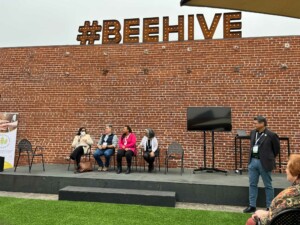Emerging Ecologies: Architecture and the Rise of Environmentalism
The Museum of Modern Art
New York
Through January 20, 2024
What does green architecture look like? There are as many answers as there are architects, it seems. Now on view at MoMA, Emerging Ecologies: Architecture and the Rise of Environmentalism sets out to document the relationship between architects and the environmental movement in the United States during the 1960s and ‘70s. At the time, many designers were engaged in the era’s sociopolitical struggles, which included environmental health in an era of oil spills, chemical contamination, and the threat of nuclear war. The task is an ambitious one, and the show plays the hits while surfacing some lesser-known entries of how this planetary consciousness influenced architects.
Emerging Ecologies is the first exhibition of MoMA’s Emilio Ambasz Institute for the Joint Study of the Built and Natural Environment, which was initiated in 2020. Carson Chan, its director, told me during a tour with his colleagues Matthew Wagstaffe and Eva Lavranou that the show’s ambition is the proposal of environmental architecture as a countermovement to modern architecture. While the latter is typically characterized by its aesthetic sameness, the former is about a diversity of approaches and resulting forms. What unites the work is its concern for “the environment,” a term that has shifted in meaning. Previously, it indicated one’s surroundings in a more neutral way; today it signals a more charged, “ecological” dimension.

The “radical” flavor of environmental thinking on view in this show is, in building terms, now old enough to be eligible for historic preservation: These ecologies are not emerging but emerged.
The exhibition’s timeline ranges from the 1930s (with Frank Lloyd Wright’s completion of Fallingwater in 1938) to the early 1990s, but the bulk of the activity took place during—and in response to—the years between the publication of Rachel Carson’s Silent Spring in 1962 and the first Earth Day in 1970. Early entries include Aladar and Victor Olgyay’s “bioclimatic” research and the Dover Sun House, created by Mária Telkes and Eleanor Raymond, which tested a method of heating using the phase-change properties of Glauber salt. Telkes’s story, which included being “undercut and thwarted by her boss and colleagues” at MIT—all men—was the recent subject of a PBS documentary, The Sun Queen.

But Emerging Ecologies also showcases canonical works. One can see projections of Buckminster Fuller’s world map along with other projects by the architect, including his Dymaxion Dwelling Machine and his head-scratching proposal with Shoji Sadao to put a dome over Midtown, apparently to reduce the costs of heating, cooling, and snow removal. Drawings and models from Emilio Ambasz are always fun to see, especially the Lucile Halsell Conservatory for the San Antonio Botanical Garden (his first built work, finished in 1982) and his Prefectural International Hall in Fukuoka, Japan, completed in 1990. Nearby, drawings by SITE’s James Wines make a welcome appearance; he also designed the poster for the show.

The era’s back-to-the-land ethos is seen in Michael Reynolds’s earthships, built mostly from plastic cans and other refuse, which he has constructed in New Mexico since 1972, and the classic Sea Ranch Ecoscore, a shell-like drawing produced in 1968 by Lawrence Halprin & Associates. The work of Sim Van der Ryn and the New Alchemy Institute is included, but that of Stewart Brand is omitted, though he appears in the timeline published in the “field guide,” the accompanying publication for the show which adds notes by Wagstaffe about each object and includes bonus content that didn’t make it into the gallery. Other “radical” architects include SCI-Arc cofounder Glenn Smalls (also the subject of a film) and Eugene Tssui, a Bay Area architect who acidified Wright’s organic architecture into more fantastic creations.

A major thread throughout Emerging Ecologies is a link between the arrival of environmental thinking and the widespread use of computers. Witness the incredible Climatron, a dome designed by Murphy & Mackey and built in St. Louis in 1960; upon entry into the jungly interior, one was confronted by the kiosk that is the Honeywell Supervisory Data Center. Other examples showcase the early power of data visualization to “image” our planet, including Ralph Knowles’s research on solar envelopes and modeling work by Beverly Willis, who designed CARLA (Computerized Approach to Residential Land Analysis) to reduce construction costs and minimize damage to natural surroundings. This synergy between mapping tools and increasingly complex regulatory constraints for development is one of the most interesting trajectories in the show.
Like Willis, other underrecognized voices—meaning, folks who aren’t white men—are given overdue appreciation. Consider the tabletop display of sketches by women from workshops led by Phyllis Birkby as part of her Women’s Environmental Fantasies project, or the work of Carolyn Dry, who imagined oil-rig–like ocean platforms grown from coral in a project sponsored by the U.S. Office of Naval Research. The checklist’s whiteness feels more like a problem of the time rather than a curatorial oversight.
The show also attends to humanity’s relationship with other species. Dolphin Embassy, a lesser-known Ant Farm creation, was to be a floating research center as documented in part from Curtis Schreier’s notebooks. But the adjacent wall sports the wildest project in the show: Dolphin Point Laboratory, in which by John C. Lilly renovated a coastal property in St. Thomas to be habitable by both people and dolphins. He wanted to see if the cetaceans could learn English. For ten weeks, Margaret Howe Lovatt, then a college student, lived there with Peter, a dolphin, and made changes like flooding the structure’s interior and deck so he could swim about freely. But the project got weird and was ultimately canceled. Of course, it was funded by NASA.
Historic protests also surface within (as well as outside of) the show. Documentation from the 1970s movement against the creation of a landfill for PCB-contaminated soil in Warren County, North Carolina: A rural, majority-Black area. It also recounts the story of the Fort McDowell Yavapai Nation, who organized against the construction of the Orme Dam in Arizona, which would’ve flooded nearly two-thirds of their land. (The landfill was eventually built, but the dam wasn’t.) Indigenous ideas, in the form of Red Power, played a role in the 1960s counterculture and are addressed with a bit more detail in Chan’s introductory essay in the field guide. Refusal can be a powerful thing: “Preventing a structure from being built is as much an architectural act as building one,” Chan said. More could be said about the role of activism; as an example, see last year’s Strikethrough: Typographic Messages of Protest, both an exhibit and catalog produced by San Francisco’s Letterform Archive.

The show’s entries largely leave the realities of civic life behind, which echoes the wider retreat from American cities in the 1970s. Stressed by the 1973–74 oil embargo, architects looked for off-the-grid, low-energy solutions, like Malcolm Wells’s visions for subterranean homes. Emerging Ecologies also includes Don Davis’s sci-fi renders for NASA, which terrifyingly reproduce suburban sprawl in space. (Ed Ruscha’s magnificent retrospective, on view three floors up, is a great aesthetic investigation into postwar American cities and their reliance on oil.) As Diana Budds hinted, we know better today: Living in compact urban arrangements is actually the way to reduce carbon emissions, a condition which counterintuitively means than Manhattanites likely have the lowest carbon footprints in the country.

Was this movement of environmental architecture a success or a failure? Only a handful of its protagonists were widely influential, and (thankfully?) we’re not yet living in bubbles or fully underground. Wagstaffe offered that there’s a “productive estrangement” with the work in the show, as some of it, like NASA’s space fantasies, inspired unfortunate lineages: Recent world-making proposals are often the stuff of snake-oil schemes or a despot’s desires. The exhibition isn’t necessarily an alternate history, as some of the practices were highly influential, but more a glimpse of what could have been had the ideas really caught on. Relatively few real buildings were produced, and what has been built is often not properly maintained: The Climatron survives today, while many Fullerian domes have not.

The exhibition’s extents end about 30 years ago, around the time when the environmental movement was absorbed into neoliberal paradigms as “sustainability.” (The USGBC began its LEED certification program in 1993, for example, around the time that Francis Fukuyama declared the end of history and Burners moved their late-summer gathering from Baker Beach in San Francisco to Black Rock Playa.) The temporal distance is productive when assessing this rich history while priming the pump for difficult questions about the current state of environmental thinking in architecture. Contemporary solutions are both more realistic and less exciting. In its marketing, MoMA claims that the show “helps us navigate the accelerating climate crisis today,” but these lessons aren’t spelled out. (They are, however, explored in a guest-edited issue of Art Papers and will be discussed at The Third Ecology, an upcoming conference in Iceland co-hosted with the European Architectural History Network.) While audio messages from leading contemporary voices looping in the gallery offer advice, I left the show inspired and unsure of how to honor this history. Knowing what we know now, what to do?
One idea was put into action days before Emerging Ecologies opened to the public, when, on September 15, climate activists staged a protest to “condemn MoMA’s ties to private equity firm Kohlberg Kravis Roberts (KKR), which has invested heavily in fossil fuel projects,” according to Hyperallergic. (MoMA’s Board Chair, Marie-Josée Kravis, is married to Henry Kravis, who cofounded KKR.) The protesters, sporting Ruscha-style placards, demanded that MoMA Director Glenn Lowry speak with Wet’suwet’en First Nation leaders, as their lands in Canada are threatened by the construction of the Coastal Gaslink Pipeline, which is in part financed by KKR. How to square the reality that an institution can both support progressive ecological inquiry and exist due to historic and ongoing patronage from the oil industry?

Environmental architecture, back in the day, could be characterized as formally exuberant, while now it retains the solemn chastity of corporate responsibility: The domes are gone, replaced by diligently sealed, rainscreened boxes designed with detailed carbon modeling and realized with precise fabrication techniques. Inasmuch as environmental thinking has become essential to architectural production, this scans as progress, even if it’s not the flashy design dreams of yesteryear. The future is not what it used to be: We were promised jetpacks and instead received e-bikes.
Though some of its contents were abandoned or one-offs, Emerging Ecologies offers much-needed inspo. Its entries stock our collective imaginations with the sense that, yes, there are ways out of our current predicament. Just as designers put in the work then, today, architects’ choices about what to engage (and, maybe more importantly, what to refuse) contain real potential to make things better. “The legacy of environmental architecture is that there are so many different methods and ways of achieving a goal,” Carson said. “It’s not just all counting points or counting carbon; one can address this in many different ways. We have to continue to do that.”










